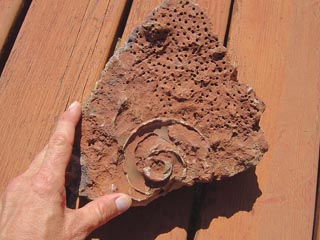 |
Fossils
From the
Redwall
Limestone
near
Young, Arizona
Thunder
Springs Member, Redwall Limestone
| 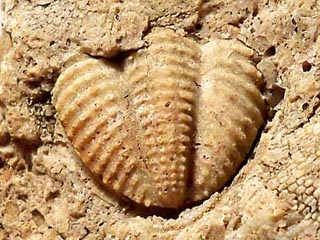 |
Updated 9/18/09
 | The 350
million year old Thunder Springs and Mooney Falls members of
the Redwall Limestone outcrop extensively on the slopes of the
Mogollon Rim in Central Arizona. Several localities of this strictly
marine sediment contain highly fossiliferous white and brown
cherts, most with molds of hard shelled marine animals that are
mostly extinct today. One of our richest localities north of
Young contains abundant fossils in reddish brown cherts, which
are so packed with fossils they have an almost foamy appearance.
Here are some highlights of a recent expedition to this locality. |
Gastropods and Corals
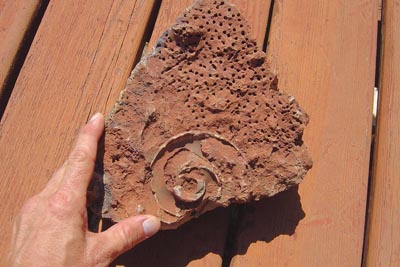 Click Thumbnail for an enlarged view
Click Thumbnail for an enlarged view
| At
the top of this magnificent piece are the long tubular holes
of the tabulate coral Syringopora (remember, these are molds),
and at the bottom is an species of a large Straparollus Utahensis
gastropod. |
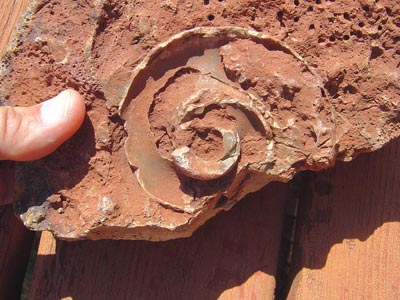 Click Thumbnail for an enlarged view
Click Thumbnail for an enlarged view
| Close
up of the Straparollus gastropod showing the thick shell this
large mollusk had. |
 Click Thumbnail for an enlarged view
Click Thumbnail for an enlarged view
| Syringopora
sp. This consists of long tubular elements with linear grooves
along their length. |
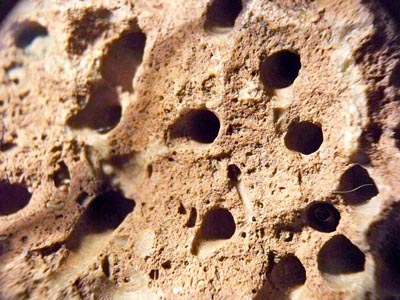 Click Thumbnail for an enlarged view
Click Thumbnail for an enlarged view
| 5x
close up of the individual corralites. |
Enchinoderms - Blastoids
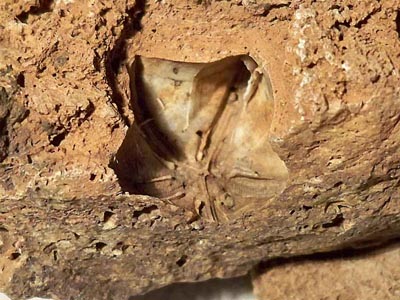 Click Thumbnail for an enlarged view
Click Thumbnail for an enlarged view
| Large
one inch sized Orophocrinus Saltensis Blastoid top half. You
can just make out the ambulacral feeding grooves inside its five
fold symmetrical body. |
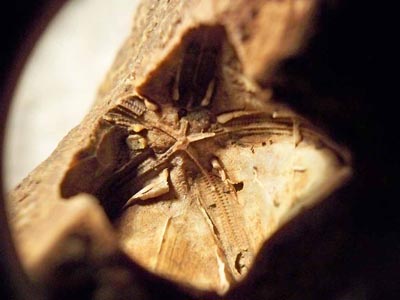 Click Thumbnail for an enlarged view
Click Thumbnail for an enlarged view
| 5x
close up of the ambulacral feeding grooves. The ribs have tiny
cross ribbing used to channel the flow of food to the animals
mouth in the center, where the five point star is located. |
Enchinoderms - Crinoids
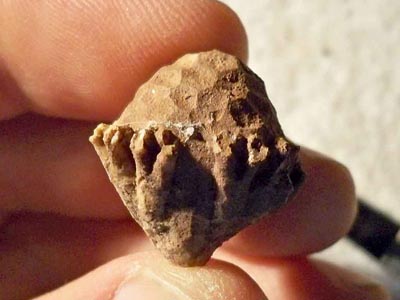 Click Thumbnail for an enlarged view
Click Thumbnail for an enlarged view
| Actinocrinitidae
calyx - internal cast, this is the central head of a sea lily.
The top cup, or "tegmen" is faceted, and the arms which
attach in pairs around the periphery would have been attached
to the ends of the forked tubes coming up from the bottom basal
cup. Where my thumb is touching is the attachment for the long
stem. |
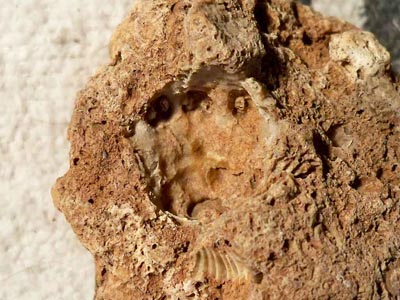 Click Thumbnail for an enlarged view
Click Thumbnail for an enlarged view
| Actinocrinitidae,
external mold. This specimen shows the exterior details of the
calyx, including the full diameter of the arms on the attachment
points. |
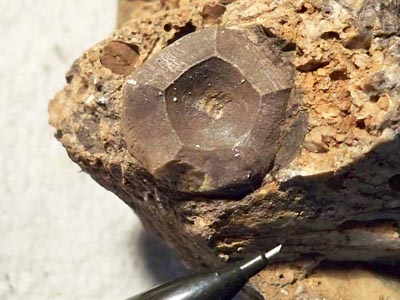 Click Thumbnail for an enlarged view
Click Thumbnail for an enlarged view
| Crinoid
dorsal cup possibly Eucladocrinus sp. The bottom plate of a species
of crinoid. |
 Click Thumbnail for an enlarged view
Click Thumbnail for an enlarged view
| Another
very small Actinocrinitidae internal cast. Since it is still
attached to the mold on the left side, you can see the the approximately
1/32 inch thick calyx walls as a gap between the two. This is
where the animals body shell would have been dissolved out. |
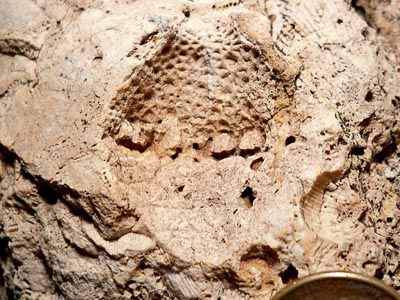 Click Thumbnail for an enlarged view
Click Thumbnail for an enlarged view
| This
very well preserved side view of an Actinocrinitidae possibly
Pyysetocrinus sp. shows exquisite ornamentation on the top and
bottom half. |
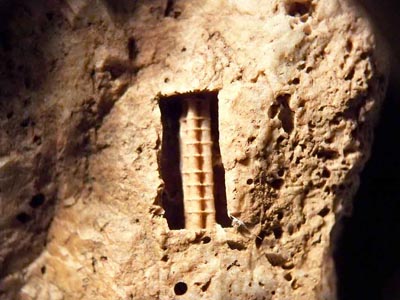 Click Thumbnail for an enlarged view
Click Thumbnail for an enlarged view
| This
close up exemplifies the mode of preservation seen in most fossils
found in the Redwall cherts, a hollow mold formed when the subject
dissolves out leaving behind the exact form in reverse. Here
we see a small 1/4 inch crinoid stem with its central canal seen
as a pillar in the middle. |
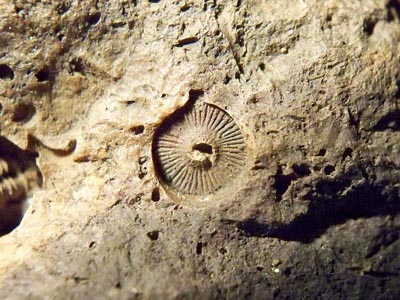 Click Thumbnail for an enlarged view
Click Thumbnail for an enlarged view
| End
on view of a similar stem, the radial internal ribs and central
canal are easily seen here. Size about 1/4 inch. |
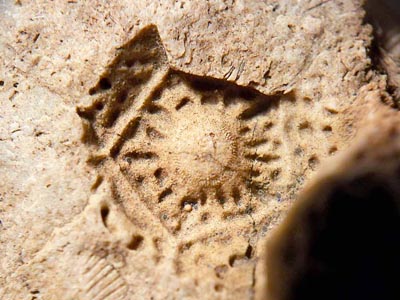 Click Thumbnail for an enlarged view
Click Thumbnail for an enlarged view
| Crinoid
basal cup from a calyx. (Platycrinites?) This is where the stem
attached. |
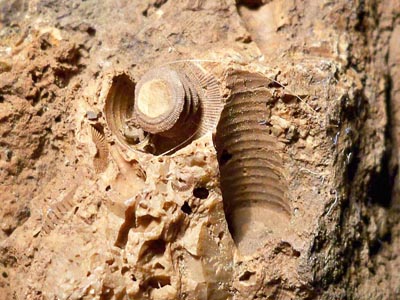 Click Thumbnail for an enlarged view
Click Thumbnail for an enlarged view
| More
larger crinoid stems. The left one is an end impression and has
a large central canal. |
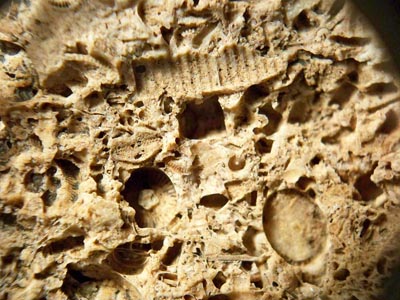 Click Thumbnail for an enlarged view
Click Thumbnail for an enlarged view
| Crinoid
hash is typical of most cherts, the countless stems, and calyx
parts form the overlying limestones. |
Gastropods
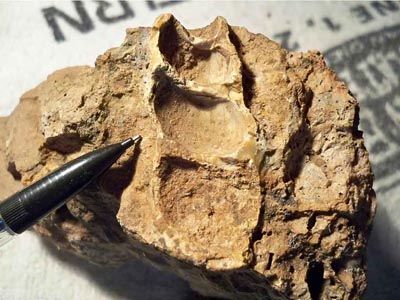 Click Thumbnail for an enlarged view
Click Thumbnail for an enlarged view
| Part
of a "Turritella type" gastropod, probably Loxonema
Knighti. Here, three whorls are seen in side view of what was
quite a large individual. |
Brachiopods
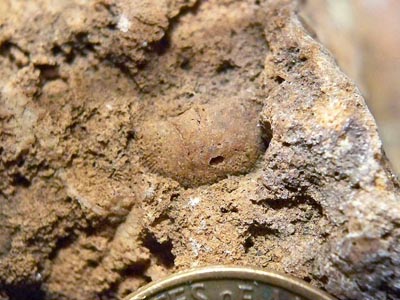 Click Thumbnail for an enlarged view
Click Thumbnail for an enlarged view
| Internal
cast of a Spirifer sp. brachiopod. A penny is at bottom for scale. |
 Click Thumbnail for an enlarged view
Click Thumbnail for an enlarged view
| A
small 3/4 inch productid brachiopod preserved as an external
cast. |
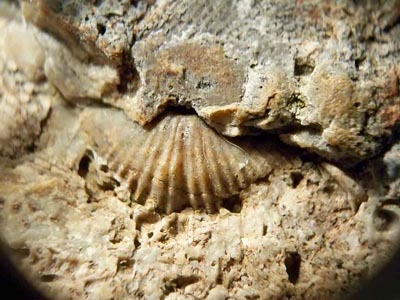 Click Thumbnail for an enlarged view
Click Thumbnail for an enlarged view
| A
small Mucrospirifer sp. brach with some very strong ribs. |
Trilobites
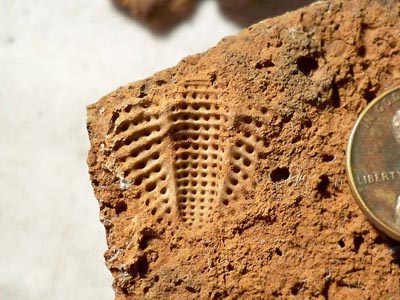 Click Thumbnail for an enlarged view
Click Thumbnail for an enlarged view
| External
mold (negative) of the most common trilobite in the Redwall,
Phillipsia Tuberculata. The second most common species in the
Redwall has only two less ribs, and is other wise exactly the
same. It is Phillipsia Sampsonii and is found in the Grand Canyon
and to the north. |
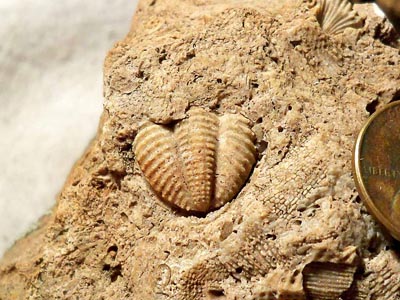 Click Thumbnail for an enlarged view
Click Thumbnail for an enlarged view
| Internal
cast of the INSIDE of the trilobites tail - the pygidium. Note
the lack of bumps and fine external details as in the above external
mold. |
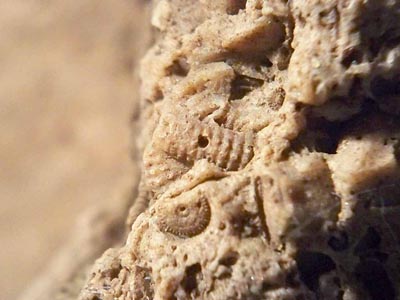 Click Thumbnail for an enlarged view
Click Thumbnail for an enlarged view
| While
examining one of the crinoidal cherts, I found this small trilobite
on one side. It is very small, perhaps only a quarter inch in
size! |
Bryozoans
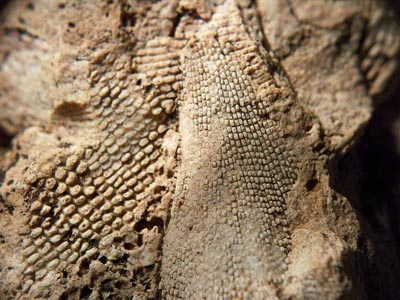 Click Thumbnail for an enlarged view
Click Thumbnail for an enlarged view
| Fenestellid
bryozoan. This net like animal was a colony of small hydra like
animals living in a spiral net around a central cylindrical core.
Nothing like them exists today, they are long extinct. On the
left is the coarser mesh Fenestella Serratula or Compressa. |
 Paleo HOME
Paleo HOME
|